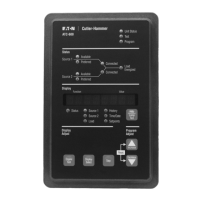For more information visit: www.eaton.com IB ATS-1005
Instructional Booklet
Page 4 Effective: March 2010
Instructions for Installation, Operation and Maintenance of the
Eaton ATC-600 Automatic Transfer Switch Controller
The features are factory activated, depending upon customer
requirements. The specific variable setpoints associated with stan-
dard and factory activated features are stored in a nonvolatile
memory. Activated feature setpoints are available for customer
adjustment. Any feature not selected and factory activated cannot
be viewed or adjusted.
Available
A source is defined as available when it is within its undervoltage/
overvoltage/underfrequency/overfrequency (if applicable) setpoint
ranges for the nominal voltage and frequency setting.
Fails
A source is defined as failed when it is outside of its undervoltage/
overvoltage/underfrequency/overfrequency (if applicable) setpoint
ranges for the nominal voltage and frequency setting.
Normal Source
The Normal Source is defined as the source that is preferred. The
Preferred Source setting allows the operator to select Source 1,
Source 2 or NONE as the Preferred Source. If NONE is chosen, the
Preferred Source or the Normal Source will be the source that is
presently attached to the load. If the Preferred Source feature is
not available from the factory, the default is set as being Source 1
as the Preferred and Normal Source.
Emergency Source
The Emergency Source is defined as the source that is not pre-
ferred. If NONE is chosen for the Preferred Source setting, the
Emergency Source will be the source that is presently not
attached to the load. Therefore, in this condition after a transfer,
what was the Normal and Emergency Sources will switch
between Source 1 and 2. If the Preferred Source feature is not
available from the factory, the default is set with Source 2 as the
Emergency Source.
Option #
For personnel who are familiar with previous transfer switch con-
troller option specifications, an attempt at equivalence to some of
the features is made.
ATC-600 features with a brief description follow. The actual pro-
grammable setpoints for each feature are covered in Section 5.
Standard Feature: Time Delay Engine Start (TDES)
TDES is used where the source is an engine generator. It delays
initiation of the engine start circuit in order to override momentary
power outages and/or fluctuations. This timer and the associated
engine start circuit will operate with or without control power.
There are two separate start circuits, one for each source when
applications of two generators are selected, although the same
TDES timer value is used for both. When one generator is
selected, this timer’s engine start circuit will operate on generator
2 for source 2. If the source that is being transferred to has a gen-
erator and that source is already available, the TDES timer is
bypassed.
Standard Feature: Time Delay Normal to Emergency (TDNE)
TDNE delays the transfer to the Emergency Source to permit sta-
bilization of the Emergency power source before the transfer is
made. This timer will begin the countdown from its setting value
when the Emergency Source becomes available. If the Normal
Source should become available during the countdown of this
timer, the timer will be aborted.
Standard Feature: Time Delay Emergency to Normal (TDEN)
TDEN delays the transfer to the Normal Source to permit stabiliza-
tion of the Normal power source before the transfer is made. This
timer will begin the countdown from its setting value when the
Normal Source becomes available. During the countdown of this
timer, if the Normal Source should become unavailable, the timer
will be aborted. If the Preferred Source is available and the Emer-
gency Source fails while the TDEN timer is counting down, the
TDEN timer will be bypassed.
Standard Feature: Time Delay for Engine Cool-Off (TDEC)
TDEC permits the generator to run under a no-load condition after
a transfer from the generator source has been made. Countdown
timing begins when the transfer is completed. In applications
where two generators are selected, the same cool-off timer set-
ting value is used for both.
Standard Feature: Time Delay Emergency Failure (TDEF)
TDEF is used where at least one source is an engine generator.
TDEF will delay an available source from being declared unavail-
able in order to override momentary generator fluctuations. This
time delay is only implemented when the load is connected to a
generator source. TDEF is not displayed when the number of gen-
erators is zero.
Standard Feature : System Nominal Frequency (NOMF)
There are only two choices for system nominal frequency of the
distribution system, 50 or 60 Hertz. The dropout/pickup, underfre-
quency and overfrequency upper and lower setting limits are
based on the nominal frequency value.
Standard Feature: System Nominal Voltage (NOMV)
This refers to the standard system nominal RMS line to line volt-
age. A wide range (120 to 600) of sensing voltage is available to
be programmed. The dropout/pickup, undervoltage and overvolt-
age upper and lower setting limits are based upon the nominal
voltage value.
Standard Feature: Undervoltage Monitoring for Source 1 (1UVD,
1UVP)
This feature constantly monitors Source 1 for an undervoltage
condition. When the Source 1 voltage drops to a value equal to or
below the undervoltage dropout setting, the source will become
unavailable. The source’s voltage will then have to rise to a value
that is equal to or above the pickup setting to become available
again.
Standard Feature: Undervoltage Monitoring for Source 2 (2UVD,
2UVP)
This feature functions the same as Standard Feature (1UVD,
1UVP), except for Source 2 instead of Source 1.
Standard Feature: Underfrequency Monitoring for Source 2
(2UFD, 2UFP)
This feature functions the same as Optional Feature 26E, except
for Source 2 instead of Source 1.
NOTICE
WITH RESPECT TO THEIR USE IN THIS DOCUMENT AND AS THEY
RELATE TO AUTOMATIC TRANSFER SWITCH OPERATION, THE FOL-
LOWING WORDS OR PHRASES ARE DEFINED:
CAUTION
CHANGING THE SYSTEM NOMINAL VOLTAGE OR FREQUENCY SET-
POINTS WILL CAUSE PICKUP AND DROPOUT SETPOINTS TO
CHANGE AUTOMATICALLY TO NEW DEFAULT VALUES.

